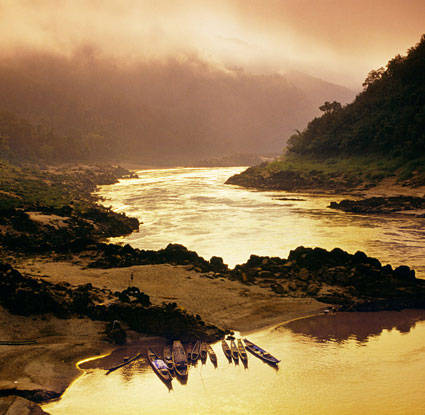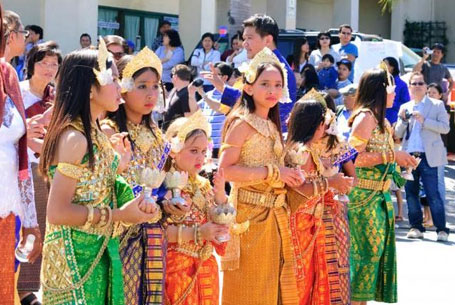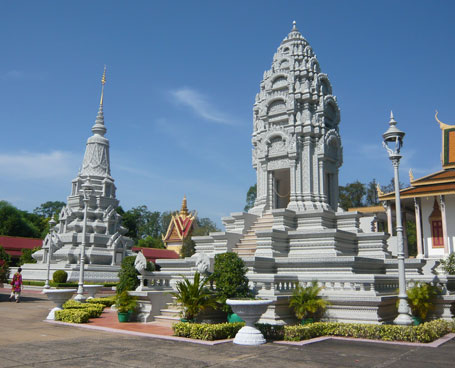Cambodia
Country statistics

Land area: 68,154 sq miles (176,519 sq km)
Total area: 69,900 sq miles (181,040 sq km)
Population (2010 est.): 14,753,320 (growth rate: 1.7%); birth rate: 25.7/1000; infant mortality rate: 53.0/1000; life expectancy: 62.5; density per sq km: 80
Capital City: Phnom Penh
Monetary unit: Riel
Languages: Khmer 95% (official), French, English
Ethnicity/race: Khmer 90%, Vietnamese 5%, Chinese 1%, other 4%
Religions: Theravada Buddhist 95%, others 5%
Country introduction

Cambodia is a country in South-eastern Asia, bordering the Gulf of Thailand, between Thailand, Vietnam, and Laos.
The dominant features of the Cambodian landscape are Tonlé Sap (Great Lake) and the Mekong River. At a length of 4,350 km (2,702 miles) the Mekong River, is the longest river in South-east Asia and the most important river in Cambodia. One of its important uses is that it is navigable for most of its run through the country from north to south, as well as the Mekong delta in the South. Tonlé Sap (Great Lake) is also the largest lake in South-east Asia, which connects with the Mekong River in Phnom Penh. Tonlé Sap enlarges to four times its normal size when the Mekong rises during the monsoon season thus causing Tonlé Sap River to flow northward into the Lake.
In the south-west lies the coastal area. The coastal boundary of Cambodia is 440 km (273 miles) with medium depth tropical sea, rich in aquatic creatures that are good for aquatic business. In addition, there are beautiful, uninhabited islands, virgin beaches, white sand and fresh air, which are also good for tourism.
A low-lying alluvial plain in the center of Cambodia makes up most of the country, although in the south there is the Mekong Delta. There are several mountainous regions, one of which forms a border along the coastline with another separating Cambodia from Thailand. Tonlé Sap Lake is covered by a highland region formed by two distinct upland blocks: the Cardamom Mountains and the Elephant Mountains. The Cardamom Mountains is more than 1,500 m (4,921 ft) high. The highest peak of Cambodia is Phnom Aoral which is 1,813 m (5,948 ft) and located in the eastern part of that range. The Elephant Mountains rises to elevations of between 500 and 1,000 m (1,640 and 3,280 ft).
The culture

Cambodia has had a rich and varied history dating back many centuries. Throughout Cambodia's long history, a major source of inspiration was from religion. Throughout nearly two millennium, Cambodians developed a unique Khmer belief from the syncreticism of indigenous animistic beliefs and the Indian religions of Buddhism and Hinduism. Indian culture and civilization, including its language and arts reached mainland South-east Asia around the 1st century AD. The first state to benefit from this was Funan.
Khmer is the official language of Cambodia. This language is immensely influenced by Sanskrit and Pali, especially in the royal and religious registers. Cambodians from different regions of the country speak variant accents, but it is understood by all people throughout the country. Having its own scripts known as Aksar Khmer, Khmer is different from neighboring languages such as Thai, Lao, and Vietnamese.
A vast majority of Cambodians follow Buddhism. Therevada Buddhism is the state religion which plays a prominent role in Khmer lifestyle. Cambodians people believe in the Karma and the cycle of death and rebirth. It is the notion that reincarnation into a higher or lower status is decided by an individual's conduct in the previous life. The Islamic faith is practiced by the Cham-Muslim communities of the south-east. Like the Buddhists, Cambodia's Muslim community also experienced persecution at the hands of the Khmer Rouge and many were killed. There are currently estimated to be around 250 mosques in the country, 90 of which are in Kompong Cham Province. Christianity accounts for a small but growing community in Phnom Penh and other urban areas. Animism continues to be the dominant faith.
The most widely celebrated festivals in Cambodia are Khmer New Year, Pchum Ben, and the Water Festival. The Khmer New Year takes place from April 13-15 where the Khmer in Cambodia spend the entire month in preparation for the celebration by cleaning and decorating their houses with candles, lights, star-shaped lanterns, and flowers. During the first three days of the lunar year, celebrants travel to the pagodas to offer food to the monks and to pray for prosperity, good health, and to show appreciation to their parents and elders. Among the many communal experiences of Khmer New Year are participation in music-making, dancing, and games. A religious ceremony called the Pchum Ben is celebrated in September which recalls the spirits of deceased relatives. The Water Festival is the most extravagant and exuberant festival in the Khmer calendar and is celebrated in October or November, at the time of the full moon. Up to a million people from all walks of life and from all over the country flock to the banks of Tonlé Sap and the Mekong Rivers in Phnom Penh to watch traditional boats racing on a huge scale. In the evening brightly decorated floats cruise along the river prior to and during the nightly fireworks displays.
Cambodian cuisine draws from the great civilizations of China and India and is also influenced by neighboring Vietnam and Thailand. There are also traces of French inspiration from the time when Cambodia was part of French Indochina. Baguette or the long French bread, for instance, has come to be Cambodia's national bread and it is common to find sandwiches made from baguette in Cambodia. The Chinese left the legacy of stir-frying; while curry dishes that employ dried spices such as star anise, cardamom, cinnamon, nutmeg and fennel were borrowed from the Indians and given a distinctive Cambodian twist with the addition of local ingredients like lemongrass, garlic, kaffir lime leaves, shallots and galangal. When blended together, the resulting paste is called a kroeung and is used widely in Cambodian cooking. Coconut is also a popular ingredient in Cambodian curries. Spring rolls made from rice paper are a popular snack in Cambodia where they are usually stuffed with fresh vegetables including carrots, lettuce leaves, beansprouts and all sorts of herbs like mint leaves, Asian basil, cilantro and spring onions or scallions.
Attractions & landmarks

The country's capital is the city of Phnom Penh, much of this city was built during French colonial occupation and despite being somewhat dilapidated in places, the city retains a lively and busy atmosphere. By far the most magnificent sight is the Silver Pagoda, its floor is tiled with over 500 silver slabs, each weighing about a kilogram. The impressive temple is also home to a 90kg solid gold Buddha and a baccarant crystal Buddha as well as many other smaller artefacts. Many tourists also make a pilgrimage to the Choeung Ek killing fields just 20 minutes south of the city. This somewhat grisly memorial is the site where the Khmer Rouge killed over 17,000 people. The Memorial Stupa is a display of about 8000 skulls catalogued by sex and age serving as a reminder of the atrocities committed by the Khmer Rouge. The onsite Tuol Sleng Museum is dedicated to educating the world about the crimes committed by the oppressive Khmer Rouge.
Most travellers come to Cambodia solely to visit the much celebrated temples of Angkor. The nearest town is Siem Reap which is only a few km from the temples and is primely situated to offer tourists food and accommodation. Angkor itself was a former religious centre with most of the temples having been built between the 9th and 13th centuries and was subsequently abandoned around the 1400s and the site was gradually lost ot the encroaching forest. Today restoration work still continues and many of the temples have been beautifully restored. The highlights are undoubtedly the Angkor Wat, Bayon and Ta Prohm temples.
Battambang is Cambodia's second largest city and is situated right on the banks of the river and boasts an airport of its own. The town boasts the best-preserved French Colonial architecture in the country and recent improvements in facilities makes this town an ideal base for visiting the surrounding temple sites. As well as the numerous Wats, the town also boasts a nearby lake and a museum of 9th century artefacts.